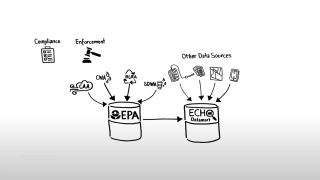Follow the Data to Answer Questions about the Environment
I love data. And I’m lucky that as an economist in the Environmental Protection Agency’s National Center for Environmental Economics, I get to play with data just about any day that I want to, and I have access to tons of data that the agency collects and produces.
So what do I do with this data? I answer questions that help the agency and our state partners protect the environment! So here’s an example... EPA’s Office of Enforcement and Compliance Assurance asked me a question to help reach their goal of improving Clean Water Act compliance: Do automatic reminder emails help facilities submit mandatory reports on time? The answer is clearly yes! But finding that answer required me looking at years of data files with tens of millions of rows (of course, I thought this was a fun challenge).

During my EPA career I’ve worked with a variety of data sets. In addition to the Clean Water Act data, I’ve used data reporting air emissions from facilities, data reporting a large variety of toxic releases, comprehensive data on public drinking water systems, and more.
My love for using data to answer important questions is shared by researchers across the country and all around the world – answering any question you can think of about the environment. However, it can sometimes be challenging to learn how to identify, access, and understand these data sets. In early May, EPA joined the Brookings Center on Regulations and Markets for a workshop to help graduate students learn about the types of data EPA creates and maintains, and how that data can be used to answer thorny questions related to the environment and public health.
Students and younger academics from all over the country talked about how they have been able to use EPA data to answer important questions. For example, if a child is exposed to pollution, could it impact overall learning? One researcher from the University of Illinois Urbana-Champaign found that exposure to lead in drinking water at birth has been shown to impact learning in children, lowering test scores and graduation rates (pdf). Another researcher from the University of Iowa found that exposure to air toxics in infancy also hampers learning in children (pdf). And these researchers developed these conclusions using EPA’s publicly available data.
Want to know how else academics are learning from EPA’s data? Here are some of the students and researchers I met:
- A graduate student from Carnegie Mellon wanted to know if EPA’s mandatory greenhouse gas reporting requirement led to an overall decrease in greenhouse gas emissions and found that it did.
- Researchers from the University of Oregon and the University of Massachusetts both wondered if unusual self-reported data might indicate environmental compliance problems and found evidence pointing to “yes.” (pdf)
- A professor from the University of Texas discussed research showing that putting serious violators on a “watch list” — and making that list public — led to large decreases in the probability of a violation.

We also talked about the complexity of EPA’s data sets, and therefore a need to understand the data and how it is generated. Did you know that the majority of the data in EPA’s data systems is reported by states? At EPA, we want to help students understand how to access and use our data on air, water, toxic chemicals, and land pollution. Our goal is to help the science community answer tough, but important environmental questions. It’s also important for us to make EPA’s data more accessible for future data nerds and reach parts of the scientific community that aren’t always in the conversation. One of the presentations at the workshop demonstrated how to use EJSCREEN--EPA’s environmental justice screening and mapping tool—which collects EPA data on environmental hazards and matches it geographically to information about low-income, minority, and other demographic data.
I’m proud of our work at EPA to follow the science and follow the data – so that we can better protect your health and our shared environment. So if you want to check out the datasets yourself, visit our open data catalog.
We also have a great training webinar coming up through our Office of Enforcement and Compliance Assurance on Tuesday, August 16th from 1:30-2:30 EDT. Learn more about downloading and analyzing data from the ECHO website.

About the Author
William Wheeler
Economist
Office of Policy, National Center for Environmental Economics
Will Wheeler works on a variety of projects but for the most part, he focuses evenly between water quality benefits and policy; and enforcement issues. He believes helping the next generation of scholars is one of the most important things that he can do and he enjoys making EPA data more accessible. He earned his PhD in Agricultural Economics from Penn State University. Prior to his current position, Will was in EPA’s Office of Research and Development, where he managed EPA’s Economics and Decision Sciences STAR grant program, and the Office of Water, where he conducted cost-benefit and other analyses for water regulations. He has published in a several journals, including the Journal of Benefit-Cost Analysis, Land Economics, and the Review of Environmental Economics and Policy; he has also authored or co-authored numerous EPA publications including the Environmental Economics Research Strategy.
Editor’s Note: The views expressed here are intended to explain EPA policy. They do not change anyone’s rights or obligations. You may share this article. However, please do not change the title or the content, or remove EPA’s identity as the author. If you do make substantive changes, please do not attribute the edited title or content to EPA or the author.
EPA’s official web site is www.epa.gov. Some links on this page may redirect users from the EPA website to specific content on a non-EPA, third-party site. In doing so, EPA is directing you only to the specific content referenced at the time of publication, not to any other content that may appear on the same webpage or elsewhere on the third-party site, or be added at a later date.
EPA is providing this link for informational purposes only. EPA cannot attest to the accuracy of non-EPA information provided by any third-party sites or any other linked site. EPA does not endorse any non-government websites, companies, internet applications or any policies or information expressed therein.
